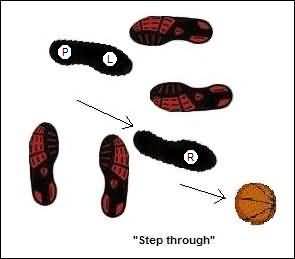Basketball Fundamentals - Escaping the Trap (Double-Team)
From the Coach’s Clipboard Basketball Playbook"Helping coaches coach better..."
There are times when the defense is pressing, either full-court or half-court, or aggressively double-teaming the pass to the wing or the corner, and you find yourself caught in a trap. How do you handle this pressure? Here are some tips.
Trapped!
First look at this picture (below). This is a really bad situation being caught in the corner, hemmed in by both sidelines. Don't let yourself get caught in a corner. Don't ever stop your dribble in the corner or along the baseline. If you've dribbled baseline and find that you've got nowhere to go, just back-dribble back out, but never stop the dribble there.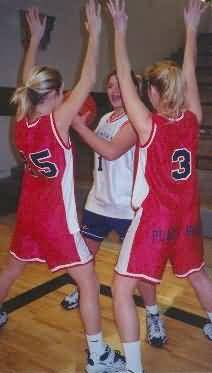
Avoid the Trap
Avoid getting caught by dribbling into one of the "trapping zones" (colored areas) seen below.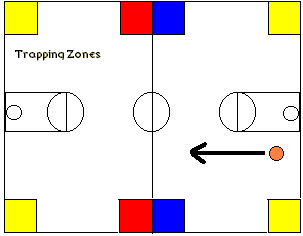
The yellow zones trap the player in the corner, like in the picture.
The red zones are favorite trapping zones, since the offensive player cannot retreat or pass the ball backward across the 10 second line.
The blue zones are good trapping zones because the offense has to worry about the 10-second count.
Back-up Dribble and Crossover
Use the back-up and crossover dribble to avoid a trap. Dribble hard backwards and then do a quick, hard crossover dribble (or a through the legs dribble or around the back dribble) to get free, attacking the defender's shoulder(show video).
Escaping a Trap
Once in a trap, get in triple threat position and get low with the ball protected on the hip. The common mistake is to stand upright and pivot away from the defenders. This allows the defenders to "squeeze" into your backside. Now you can neither see the floor, nor can you pivot.You could call "time-out", if it's late in a close game, and you a few time-outs left. But coaches hate wasting time-outs early in a game.
If caught in the corner as in the photo above, you don't have a lot of options for dribbling out, since you are caught right up against the baseline. Look to pass - you've got five seconds. You could try to create some contact by pivoting (but no "elbows"). The ref might bail you out by calling a foul on a defender.
If you are close to the 5-second call, you could try throwing the ball hard off a defender's leg, so it goes out-of-bounds (get out of the way so that it doesn't come back and hit you). These are desperate measures that we don't ordinarily like. If you still have your dribble, we prefer the two methods below.
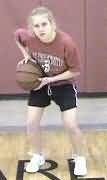
Triple-Threat Position
"Take an Outside Leg"
If you have a little room along the sideline, from triple-threat position, if you can't find someone to pass to - "take an outside leg". Get your leg around the outside leg of one of the defenders and bust out of there with a dribble. In the diagram, the left foot is your pivot foot. Get low and take a long step with your right foot around the defender's outside foot, while pushing the ball forward, protecting it with your body.If you have to go the other way, stay low, make a spin move by reverse pivoting away from the defenders (on the left foot). When coming out of the spin, aggressively extend your right foot around the defender's outside leg, and dribble the ball out of there.
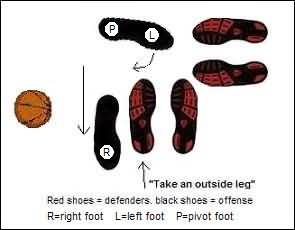
"Split the Trap"
If the trappers are not "knee-to-knee", then "split the trap". From triple-threat position, stay low and aggressively step thru, between the two defenders, and dribble out of there. This is a little like a "football move", like a running back getting low and running thru the line.In either case, you've got to be tough and strong. Don't be afraid to make contact with the defenders. As long as you don't swing an elbow, the offensive player is hardly ever called for a foul in this situation.
